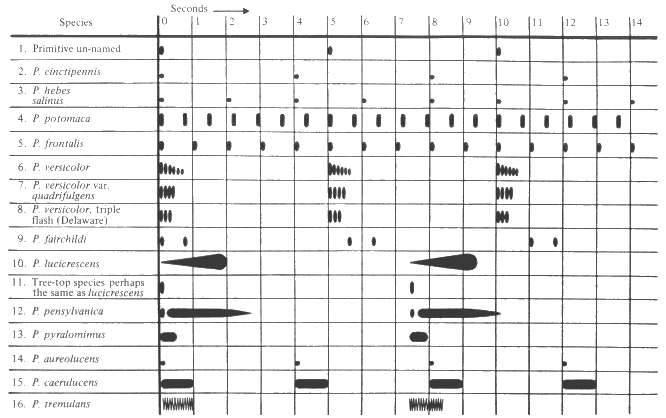Simulation of firefly
Zápisník experimentátora
Hierarchy: Svätojánska muška v pohári
Last year I started a topic about a fireflies. In this article we look at how this insect produces light and how can we imitate light using Arduino. We will simulate the circuit using the 74HC595 and library ShiftPWM.
In the nature
Firefly is a popular name for lampyris noctiluca. This is an insect that can glow in the night by a phenomenon called bioluminescence. Thanks to light, people feel that it would be nice Bug with a lamp, but in fact it's pretty ugly insects. Fortunately, it is not visible at night so we can sometimes watch strange lights in the meadow and ride the wave of our imagination.
In nature, there are several species of fireflies with unique pattern of flashing. Someone collected these patterns. From the following table I created the patterns.

Preparation of patterns
At the table there was no explanation, so I modified the data freely. I estimated roughly that the table is development of intensity in time. I wrote a simple program that places the samples portrayed ellipse with a maximum of 255 points, and then I had to calculate the highest value in each column. I proceeded this way for each sample and the result is an array of several samples.
Hardware
We will need the following components:
- Arduino UNO - I'm using Arduino Pro Mini in the video and sketch is written in IDE 1.6.7.
- 74HC595 - Shift Register. I use my own board, which can be used on the breadboard.
- 8x LED with the corresponding 330R resistor - I use my own board, which can be used on the breadboard.
The sketch
I defined the following behavior:
- Time between samples is 10 ms.
- I used a shift register 74HC595 and 8 LEDs. If necessary, it is possible to add more LEDs.
- The brightness of each LED controls ShiftPWM library, which is a very convenient way for programming.
- Each firefly is one state machine and uses tree states: waiting, flashing and tired.
- Waiting firefly do not flashes and can be in a random moment switched to flashing state.
- Flashing firefly every 10 ms draws its sample. The selected pattern can be repeated few times. When stops blinking, it enters the state of tired.
- Tired firefly need few seconds to relax.
- The light of flashing is adjusted to human eyes.
Program is split into few parts.
- pattern.h - Definition of random fireflies patterns.
- light.h - Definition of light adjustment.
- firefly.h - Definition of fireflyes states.
- hc595_led_shiftpwmfirefly01.ino - Main program.
Definition of patterns
Example of one sample is in the following code. Each number represents one luminance sample at a time. Every 10 ms a new value is sent to the LEDs.
PROGMEM const unsigned char carolinus[31]={
25, 99, 133, 159, 177, 193, 206, 206, 215, 224,
231, 237, 242, 246, 248, 250, 248, 246, 243, 238,
232, 224, 215, 206, 193, 178, 178, 159, 133, 100,
26};
#define MAX_PT 11
struct pt
{
int length;
const unsigned char *pattern;
const char *name;
int dela;
}
pt[MAX_PT]={
{41,marginellus,"Marginellus",230},
{21,sabulosus,"Sabulosus",350},
{91,pyralis,"Pyralis",480},
{61,umbratus,"Umbratus",590},
{61,collustrans,"Collustrans",180},
{31,ignitus,"Ignitus",470},
{81,consanguineus,"Consanguineus",470},
{181,greeni,"Greeni",370},
{231,macdermotti,"Macdermotti",320},
{21,consimillis,"Consimillis",20},
{31,carolinus,"Carolinus",30},
};
Definition of firefly
Each state is defined in enum.
enum ffstate {
ffIdle=0,ffActive,ffTired};
The firefly is defined through the following structure. It allows you to save the state, randomly selected pattern of flies, the position when playing the sample, length of the sample, the time during which the firefly is tired and number of repetitions of the patterns.
struct firefly
{
ffstate state;
const unsigned char *pattern;
int pos;
int length;
long tired;
int repeat;
};
The main program is then defined array of fireflies, corresponding to the number of LEDs with defined init state ffIdle, which means that each position is shot ready for flashing.
firefly f[8]={
{ffIdle,NULL,0,0,0,0},
{ffIdle,NULL,0,0,0,0},
{ffIdle,NULL,0,0,0,0},
{ffIdle,NULL,0,0,0,0},
{ffIdle,NULL,0,0,0,0},
{ffIdle,NULL,0,0,0,0},
{ffIdle,NULL,0,0,0,0},
{ffIdle,NULL,0,0,0,0}
};
Main program
Main program calculates transitions between states and animation of patterns. Light level is modified to compensate nonlinear characteristic of human eyes.
In function setup we must set few parameters of ShiftPWM library. We must setup random number seed from noise of unconnected analog input.
void setup() {
Serial.begin(9600);
ShiftPWM.SetAmountOfRegisters(numRegisters);
ShiftPWM.SetPinGrouping(1);
ShiftPWM.Start(pwmFrequency,maxBrightness);
ShiftPWM.PrintInterruptLoad();
randomSeed(analogRead(0));
}
In function loop we switch between states of the firefly. Firefly can be created on any free LED.
void loop() {
mil=millis();
for(int i=0;i<8;i++)
{
switch(f[i].state)
{
case ffIdle:
r=random(2000);
if(r<10)
{
f[i].state=ffActive;
r=random(MAX_PT);
printActive(i);
f[i].pattern=pt[r].pattern;
f[i].pos=0;
f[i].length=pt[r].length;
f[i].repeat=1+random(3);
}
break;
case ffActive:
value=pgm_read_byte(f[i].pattern + f[i].pos);
value=pgm_read_byte(&table[value]);
ShiftPWM.SetOne(i,value);
f[i].pos++;
if(f[i].pos==f[i].length)
{
f[i].repeat--;
if(f[i].repeat)
f[i].pos=0;
}
if(f[i].pos==f[i].length)
{
ShiftPWM.SetOne(i,0);
f[i].state=ffTired;
f[i].tired=mil+500+random(10000);
printTired(i);
}
break;
case ffTired:
if(f[i].tired<mil)
{
f[i].state=ffIdle;
printIdle(i);
}
break;
}
}
delay(10);
}
Github
Source code of generator, which creates file firefly.h.
Video
In the video you can see as flies blinks.
What next
Now we can create fireflies in a jar. Hay, few wires and electronics in a glass jar.
Download
- 74HC595 - Datasheet 74HC595 - 8-bit shift registers with 3-state output registers
- Firefly Sketch v. 1 - Firefly Simulator
19.01.2016